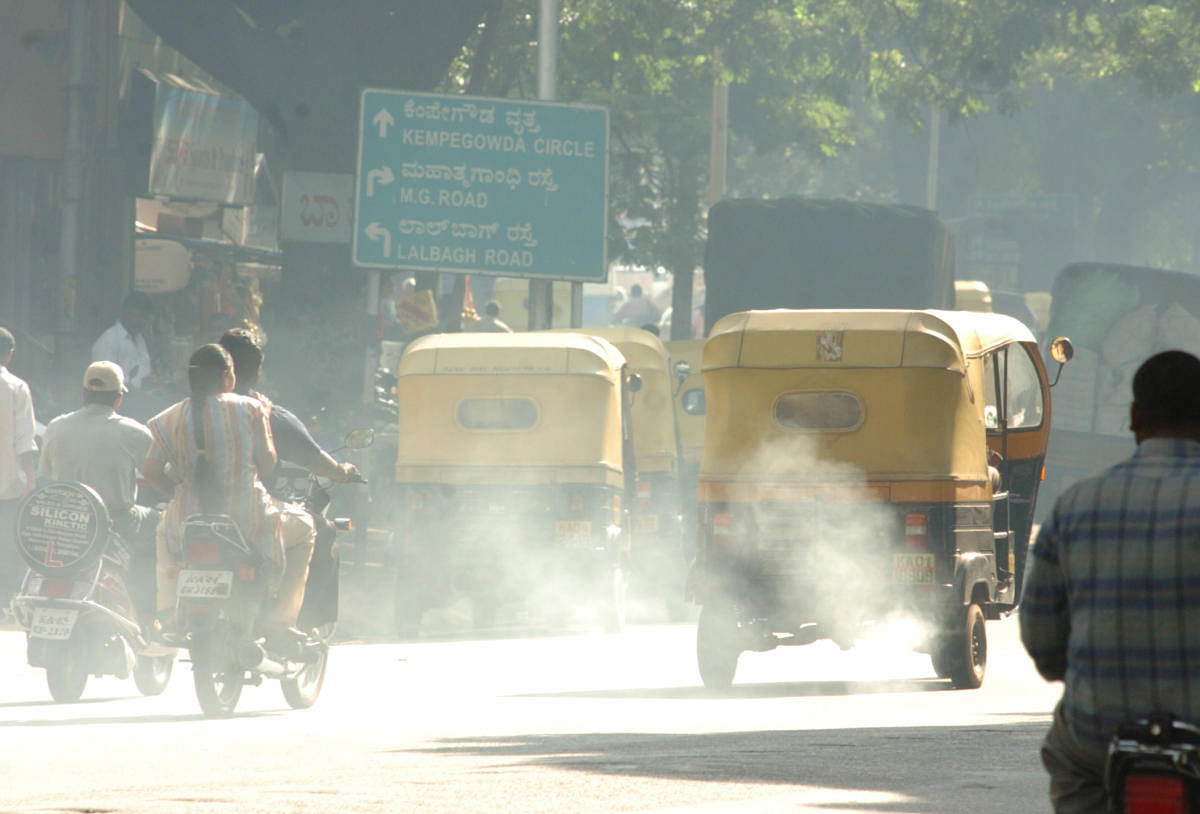
The wintry chill is in the air, and the Bengalurean’s pollution worries have begun to soar. The potent mix of vehicular exhaust, road dust, industrial emissions and construction dust threatens to push the pollution graph way beyond the permissible limits. Is Bengaluru turning into another Delhi?
First, the season fundamentals. During the year outside the November-February winter window, the pollutants are spread out over a height of about a kilometre. But as temperatures drop in winter, this mixing height reduces by half. The pollutants are then packed into a lesser space, with higher density.
25 per cent increase
The implication is clear: The air close to the ground gets much more polluted than before. The Karnataka State Pollution Control Board (KSPCB) estimates that the level of all pollutants rises by about 25%. But, considering Bengaluru’s explosive vehicular growth and unbridled development, this could get way too dangerous to breathe.
Pollution values recorded by 21 monitoring stations of KSPCB and three stations run by the Central Pollution Control Board (CPCB) confirm this trend. The Particulate Matter 2.5mm (PM 2.5) limit is 60 micrograms per cubic metre for 24-hours. This limit is consistently exceeded although lately, there has been a slight reduction in the annual average.
Faltering strategies
But, as environmentalists point out, the mitigation strategies to effect a holistic course correction has faltered. There is no visible, concrete action on the ground to regulate the explosive growth in vehicular numbers. For a city of 1.3 crore, the number of registered vehicles has already crossed 77 lakh. In the next four years, this is projected to exceed a crore.
Despite grand declarations of intent to ban them, vehicles that are 15 years or older still roam the city’s streets, spewing toxic smoke. By taking the legal route, the powerful truckers lobby has ensured that the ban is not implemented. Besides, zero emission electric vehicles are too few in numbers to make any identifiable impact.
Road-dust challenges
So, how do motorcyclists, the traffic police constables and the footpath vendors, the people most vulnerable to vehicular exhaust cope up? How do they deal with the road dust that perennially stays re-suspended in the air due to constant vehicular movement?
They use face masks, a majority of which are of inferior quality and are thus more dangerous than not wearing any mask at all, points out a KSPCB official, preferring anonymity. The cheap PVC material in the masks disintegrate into smaller particles due to prolonged exposure to sunlight. Inhaling these particles can trigger severe health hazards, the official warns.
Construction dust
Beyond vehicular emissions, construction dust poses a potent threat to the health of Bengalureans. “Demolition and construction projects are happening everywhere. We have instructed builders to cover such areas and spray water.”
Early this year, the government had issued directions that the 2016 National Green Tribunal (NGT) norms on dust pollution should be strictly implemented by all agencies concerned. These included the Bruhath Bengaluru Mahanagara Palike (BBMP), Bangalore Development Authority (BDA), Public Works Department (PWD) and the Bangalore Metro Rail Corporation Limited (BMRCL).
NGT guidelines, orders
The directions were clear: To ensure regular watering at construction sites, cover trucks ferrying building material, use tarpaulin covers to prevent dust from under-construction sites to spread to public spaces, and a strict no-no on dumping construction material such as sand on the roads and residential areas.
Builders also had to fix sprinklers, create green air barriers and mandatorily install wet-jets in stone-cutting and grinding in the vicinity of construction sites. A penalty of Rs 50,000 was fixed for any builder or building owner caught violating the dust control guidelines.
Yet, these measures have apparently failed to make any noticeable change. Public and private construction projects still trigger tons of fine dust particles, site workers are still without protection and are exposed to risk of contracting serious respiratory diseases.
Health hazard
The alarming rise in the proportion of Particulate Matter 2.5 (PM 2.5) in the air can really start biting once the temperatures begin to drop drastically. Tiny, fine particles or droplets in the air that are two and half microns or less in width, can quickly penetrate deep into the human respiratory tract, causing immense damage to the lungs.
Prolonged exposure to fine particle pollutants has been proven to be the cause for eye, nose, throat and lung irritation; coughing, sneezing, runny nose and shortness of breath.
Coordinated approach
Urban planners and public policy experts are unanimous that without a coordinated, multi-agency approach, the pollution issue cannot be addressed with any efficiency.
For instance, the city’s pourakarmikas will have to be trained and equipped to clear the daily garbage totally without leaving any remnants. Garbage-burning will have to be quickly identified and the violators punished severely.
But addressing the vehicular exhaust problem will have to be the priority. And, all the stakeholders involved, the KSPCB, the BBMP and the traffic police know where to start: Central Silk Board Junction or Whitefield or Mysuru Road near AMCO batteries.